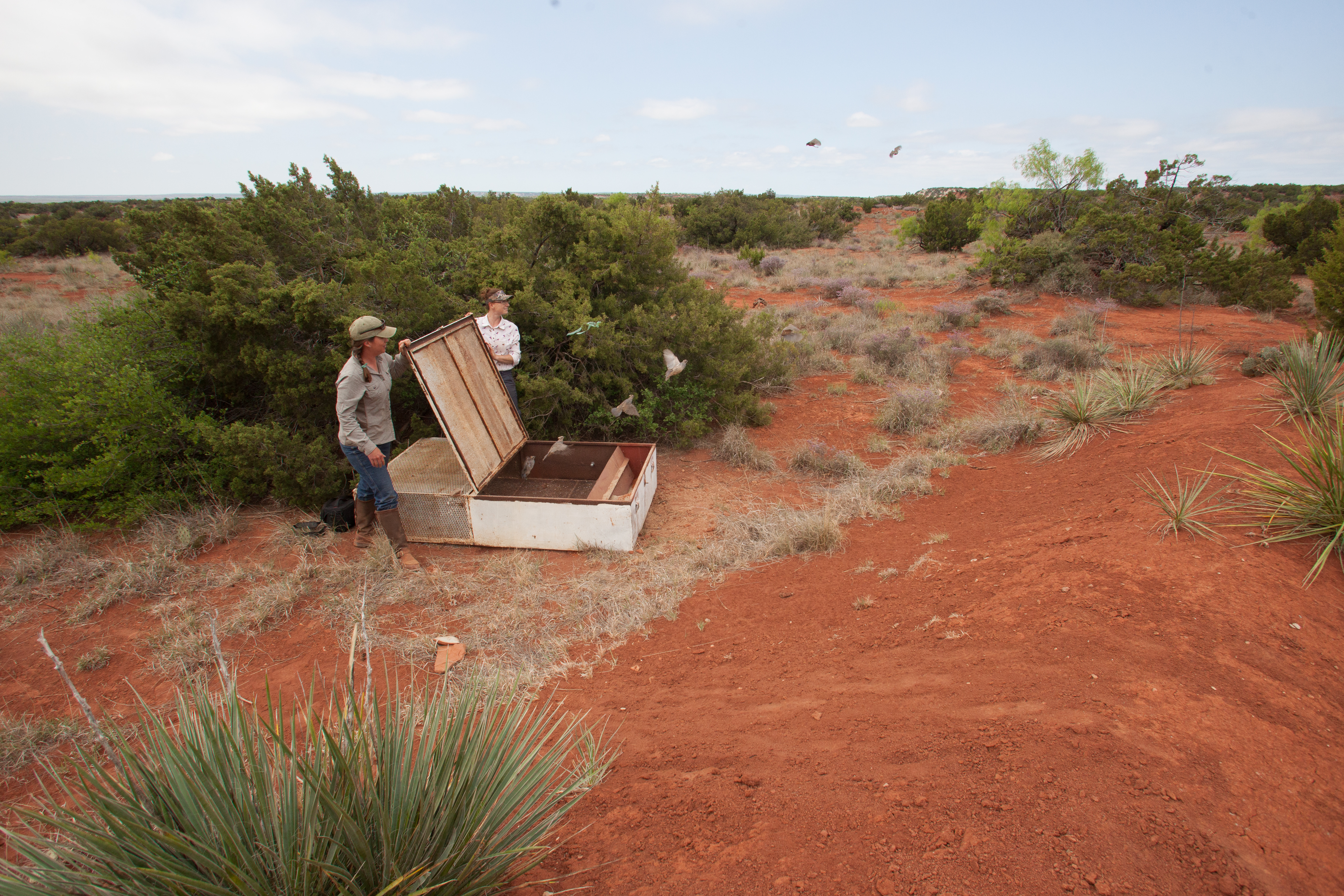HOME
Scaled quail research hopes to pave way for the bird’s Rolling Plains comeback

By Russell Graves
After a night’s rain, the red dirt Knox County ranch roads in which Becky Ruzicka drives are a bit soft, even muddy in places.
Undaunted, she drives her Kawasaki Mule through the barbed wire gate and past cedars and mesquite trees, all the while watching a GPS unit that tells her the position of each quail surrogator she has stationed on the vast Texas rangelands.
“Through this research we hope to determine the effectiveness of using translocation as a tool to reestablish scaled quail populations within the Rolling Plains,” she explains while gathering up needed equipment before we make a short walk through the brush to the first location where she’ll release a bevy of birds.
“Specifically,” she contends, “this study is designed to help us identify best practices for scaled quail translocation.” As part of Texas A&M University’s Reversing the Decline of Quail in Texas initiative and a continuation of the Rolling Plains Quail Research Ranch (RPQRR)’s Operation Transfusion project, she hopes to unlock the secrets that, to date, have prohibited scaled quail from inhabiting every niche of their historical range in Texas.
According to Texas Parks & Wildlife Department maps, the historic range of scaled quail is generally on a line that extends a couple of counties east of the 100th meridian (roughly US 83).
To read more pick up a copy of the September 2016 NTFR issue.
HOME
Preparing Spring Gardens

By Hannah Claxton | Editor
The North Texas area is located within USDA Hardiness zones seven and eight. The zones are categorized by predicted low temperatures for winter and timing of the first and last frosts.
Zone seven usually has winter low temps between 0 and 10 degrees F with the average date of the first frost falling between Oct. 29 and Nov. 15 and the average date of the last frost falling between March 22 and April 3.
Overall, these two zones have similar climates and growing conditions, making the options for timing and variety within a garden very similar.
In these zones, cool-season crops should go in the ground in March, meaning that soil preparation should start now.
To read more, pick up a copy of the January edition of North Texas Farm & Ranch magazine, available digitally and in print. To subscribe by mail, call 940-872-5922.

HOME
Equine Vaccinations

By Heather Lloyd
Vaccinations are a critical component of maintaining the health and well-being of horses, especially in environments where they are exposed to other animals, such as in the sport, show and performance arenas. Horses, like all animals, are susceptible to various infectious diseases that can spread quickly and cause serious harm.
A routine vaccination schedule helps prevent the spread of these diseases by preparing the horse’s immune system.
To read more, pick up a copy of the November edition of North Texas Farm & Ranch magazine, available digitally and in print. To subscribe by mail, call 940-872-5922.

HOME
Wichita Falls Area Cattlewomen

Having herds on a controlled breeding schedule means that we have a predictable calving schedule, and while it’s only over a couple of months, for us it does fall right after the start of the year. I lobby annually to call ours the “Winter calving season”, but I am outvoted and my husband still refers to it as Spring. Unlike producers in our Northern States, we don’t have to contend with brutally harsh winter weather, and on those rare times we do, thankfully it is not for extended periods. Regardless of whether you have a Spring or a Fall calving schedule, the health of a newborn calf begins with the mother’s health, and the mother’s health is largely dependent on the producer.
To read more, pick up a copy of the November edition of North Texas Farm & Ranch magazine, available digitally and in print. To subscribe by mail, call 940-872-5922.

-

 Country Lifestyles2 years ago
Country Lifestyles2 years agoScott & Stacey Schumacher: A Growth Mindset
-

 Country Lifestyles8 years ago
Country Lifestyles8 years agoStyle Your Profile – What your style cowboy hat says about you and new trends in 2017
-

 HOME8 years ago
HOME8 years agoGrazing North Texas – Wilman Lovegrass
-

 Outdoor10 years ago
Outdoor10 years agoButtercup or Primrose?
-

 Country Lifestyles5 years ago
Country Lifestyles5 years agoAmber Crawford, Breakaway Roper
-

 Country Lifestyles9 years ago
Country Lifestyles9 years agoJune 2016 Profile – The man behind the mic: Bob Tallman
-

 Country Lifestyles8 years ago
Country Lifestyles8 years agoDecember 2016 Profile, Rusty Riddle – The Riddle Way
-

 Equine1 year ago
Equine1 year agoThe Will to Win




